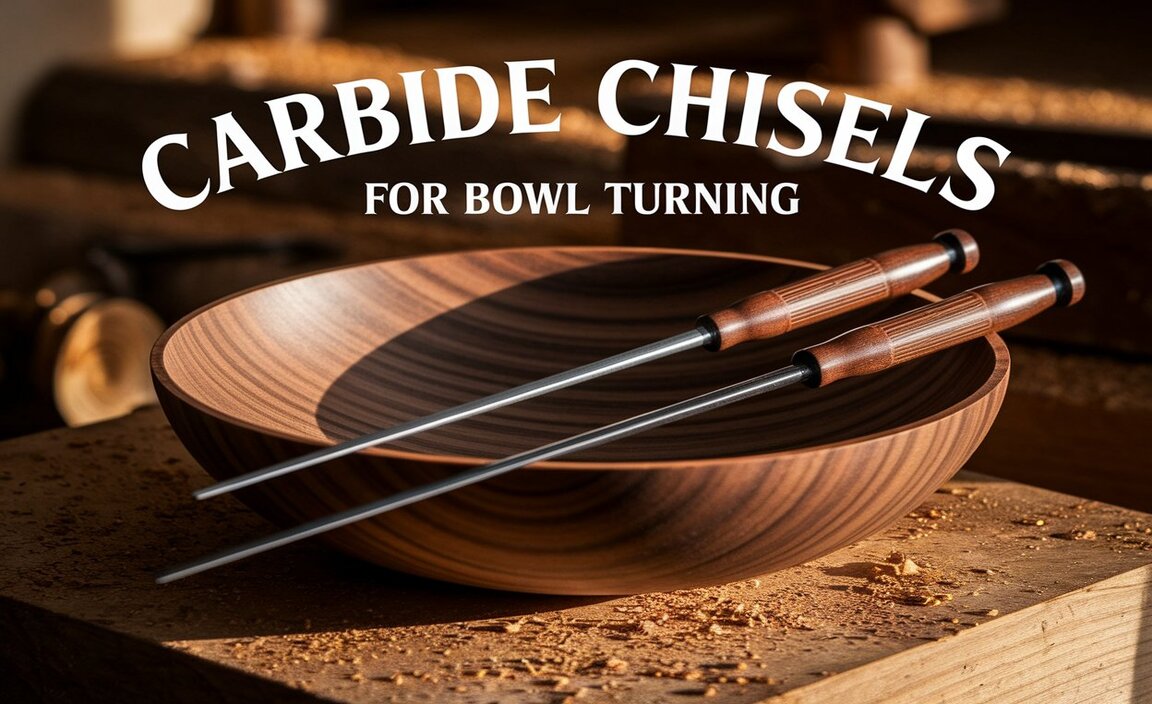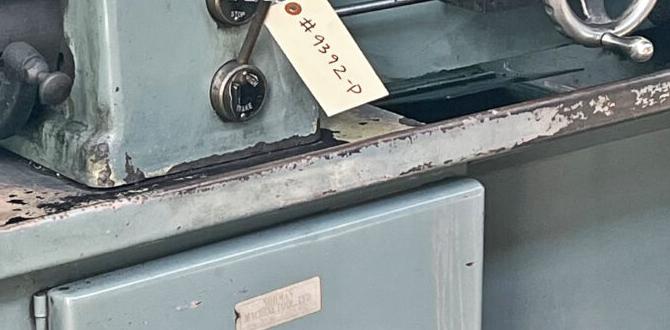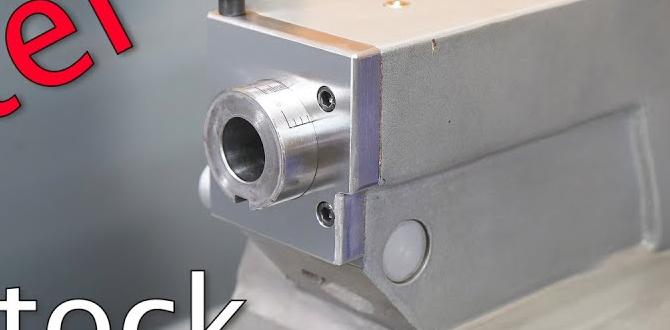Unlock a Mirror Finish on Tool Steel with a Carbide End Mill!
Achieve a brilliant, mirror-like finish on tough tool steels like D2 with the right carbide end mill. This guide shows beginners how its precise geometry and material make achieving a “genius” finish achievable, even with a 1/8 inch or 10mm shank.
Working with hard steels like D2 can be intimidating, especially when you’re aiming for that perfect, shiny surface finish. You might have tried various cutters, only to end up with a dull, scratched, or even burnt workpiece. It’s a common frustration for anyone venturing into machining tool steels. But what if I told you there’s a specific type of tool that can make achieving a “genius” steel finish surprisingly straightforward? That’s right, the carbide end mill, particularly those designed for finishing, is your key. In this guide, we’ll break down exactly why these end mills are so effective and how you can use them to get that sought-after mirror polish on your projects.
We’ll dive into the specifics of what makes a carbide end mill so special for tool steel finishing, from its geometry to its material properties. You’ll learn what to look for when choosing the right end mill – whether you need a tiny 1/8 inch shank for intricate work or a more robust 10mm shank for larger cuts. Get ready to transform your projects from good to exceptional, with a step-by-step approach that’s perfect for beginners. Let’s get your workpieces looking their absolute best!
Carbide End Mill: Your Secret Weapon for Steel Finishes
When it comes to achieving a superior surface finish on demanding materials like D2 tool steel, the right cutting tool makes all the difference. Traditional high-speed steel (HSS) end mills can struggle, leading to tool wear, poor finish, and even material damage. This is where carbide makes its entrance. Carbide end mills are engineered with specific properties that allow them to cut harder materials more effectively and at higher speeds, leading to cleaner cuts and a superior finish.
Think of it like this: HSS is like a sturdy but slightly softer knife, while carbide is like a diamond blade. Both can cut, but the diamond blade cuts through tougher materials with less effort and leaves a smoother edge. For beginners, this means less frustration and more impressive results. The key is understanding why carbide is superior for this task and how to select the right carbide end mill for your specific needs.
Why Carbide Excels for Tool Steel Finishing
Carbide, specifically tungsten carbide, is a composite material made by pressing and sintering tungsten carbide powder with a binder, usually cobalt. This process creates a material that is incredibly hard and rigid, far more so than HSS. This hardness is the primary reason it excels in cutting tough materials like hardened tool steels.
- Superior Hardness: Tungsten carbide is second only to diamond in hardness among common materials. This allows it to cut through hardened steels without deforming or rapidly wearing down.
- High Rigidity: Carbide is also much stiffer than HSS. This means it deflects less under cutting forces, leading to more precise cuts and a better surface finish. Less chatter also contributes to a smoother surface.
- Heat Resistance: While not as heat-resistant as some ceramics, carbide can withstand much higher cutting temperatures than HSS. This is crucial when machining tool steels, which generate significant heat due to their hardness.
- Wear Resistance: The hardness translates directly into excellent wear resistance. A carbide end mill will maintain its sharp cutting edge for much longer than an HSS equivalent when working with tough materials.
For a beginner, these properties translate to a tool that’s more forgiving. You’re less likely to ruin a workpiece or the tool itself due to minor mistakes in feed rate or depth of cut. This confidence in the tool is vital when learning new machining techniques.
Understanding “Tool Steel Finish” and Mirror Polish
When we talk about a “tool steel finish” on a piece of machinery or a custom project, we often mean more than just a smooth surface. We’re talking about a functionally superior surface and an aesthetically pleasing, often reflective, finish. For tool steels like D2, achieving a mirror polish isn’t just for show; it can improve performance and durability by reducing friction and improving resistance to corrosion.
A mirror finish means the surface is so smooth that it reflects light like a mirror. This is typically achieved through specific finishing passes with very fine chip loads and high surface speeds, using a cutting tool with a geometry designed for this exact purpose. The right carbide end mill, with its precision and ability to hold an edge, is fundamental to reaching this level of quality.
Choosing the Right Carbide End Mill for Tool Steel
Not all carbide end mills are created equal, especially when you’re chasing a premium finish on hard materials. You need to consider several factors to ensure you select the right tool for the job. This includes the material of the end mill itself, its geometry, and its intended use (roughing vs. finishing).
Carbide Grade Matters
The specific grade of carbide used in the end mill plays a significant role. For general machining of steels, a medium-grain carbide with a good balance of hardness and toughness is usually recommended. However, for finishing and working with very hard materials, you might lean towards grades with higher cobalt content for better toughness or finer grain structures for increased hardness and wear resistance. Manufacturers often specify the recommended applications for their different carbide grades.
For a beginner, looking for end mills explicitly labeled for “finishing” and “high-hard steel” is a good starting point. You don’t need to become a material scientist overnight, but understanding that there are different types of carbide used is helpful.
End Mill Geometry: Key to a Smooth Cut
The physical shape and design of the end mill (its geometry) are critical for achieving a good finish. For tool steel finishing, you’ll typically want an end mill with the following features:
- Number of Flutes: For finishing operations, end mills with more flutes (e.g., 4, 6, or even 8 flutes) are often preferred. More flutes mean a finer pitch between cutting edges, which allows for smaller chip loads and a smoother surface finish. However, fewer flutes (e.g., 2 or 3) can sometimes be beneficial for chip evacuation in softer materials or deeper cuts, but for finishing tool steel, more flutes are generally better for finish quality.
- Helix Angle: A higher helix angle (e.g., 30° to 45°) generally results in a smoother, quieter cut and better chip evacuation. For very hard materials and a mirror finish, a standard 30° helix is a good compromise between cutting action and chip control.
- Coating: While not strictly geometry, coatings are applied during manufacturing to enhance performance. For tool steels, coatings like TiAlN (Titanium Aluminum Nitride) or AlTiN (Aluminum Titanium Nitride) are excellent choices. They increase hardness, improve lubricity (reducing friction and chip welding), and enhance thermal resistance, all of which contribute to a superior finish and longer tool life.
- End Cut Type: For general profiling and finishing, a square end (flat) end mill is common. However, if you’re aiming for a radiused corner or a specific shape, you’d opt for a ball-end or corner-radius end mill. For a flat surface finish, a square end mill is usually what you’ll be using.
- Relief Grinds: High-quality finishing end mills often have specialized relief grinds on the cutting edges. These help to reduce rubbing and improve the cutting action, leading to a cleaner cut and a better finish.
Shank Size: 1/8 Inch vs. 10mm and Beyond
The shank is the part of the end mill that the tool holder grips. Shank size is determined by your machine’s spindle collet or tool holder capacity. For a “carbide end mill 1/8 inch 10mm shank extra long for tool steel D2 mirror finish,” you’re looking at specific applications of these sizes:
- 1/8 inch (approx. 3.175 mm) Shank: This is a very small diameter. These end mills are ideal for intricate details, small parts, or when working on a very small CNC mill or engraving machine. When using such a small diameter on hard steel, you must be extremely cautious with machining parameters. They are often described as “micro end mills” and require very delicate handling and often faster spindle speeds.
- 10mm Shank: This is a more common and robust shank size, suitable for a wider range of milling machines. A 10mm shank end mill, especially a larger diameter one (e.g., a 6mm or 8mm cutter with a 10mm shank), will offer more rigidity and allow for higher feed rates and depths of cut compared to a 1/8 inch shank.
- “Extra Long”: This indicates the overall length of the end mill. An “extra long” end mill is designed to reach deeper into workpieces or pockets. While useful for reach, be aware that longer tools are more prone to deflection and vibration, which can negatively impact finish. For critical finishing, a shorter, more rigid tool is often preferred if reach isn’t a primary concern.
When specifying “carbide end mill 1/8 inch 10mm shank extra long for tool steel D2 mirror finish,” it suggests you might be looking for options across these sizes, or perhaps a specific tool that combines some of these features. You’ll need an end mill that is specifically designed for finishing tough steels and has the correct shank diameter and flute count.
Step-by-Step: Achieving a Mirror Finish with Your Carbide End Mill
Getting that perfect mirror finish isn’t just about having the right tool; it’s also about using the right techniques. This process involves careful setup, precise machining parameters, and often a dedicated finishing pass. Here’s a breakdown for beginners:
1. Machine and Tool Preparation
Before you even think about cutting, proper preparation is key to success. This ensures stability, accuracy, and safety.
- Secure Your Workpiece: Ensure your D2 tool steel workpiece is clamped firmly and rigidly. Any movement will ruin your finish. Use a vise with soft jaws if necessary to protect the surface while ensuring a strong grip elsewhere.
- Secure Your Tool: Always use a good quality collet or tool holder to firmly grip the end mill shank. A loose tool is dangerous and will result in a poor finish. For small shanks like 1/8 inch, a precision collet set is invaluable.
- Set Your Zero Point Accurately: Use a touch probe, edge finder, or dial indicator to accurately set your X, Y, and Z zero points. Precision here is paramount for consistent results.
- Clean the Machine: Ensure your machine’s ways, spindle, and tool holder are clean and free of debris.
2. Machining Parameters: The Sweet Spot
This is where experience often comes in, but for beginners, using recommended guidelines is essential. Speed and feed rates are the most critical parameters. For a mirror finish:
- Spindle Speed (RPM): You generally want to run carbide end mills at higher surface speeds than HSS. The ideal speed depends on the diameter of the end mill, the material, and the coating. For finishing D2 steel with a coated carbide end mill, speeds can range from 200-600 SFM (Surface Feet per Minute). Convert this to RPM based on your end mill’s diameter. For example, a 1/4 inch (0.25 inch) end mill needs to achieve ~764 RPM to reach 500 SFM. (RPM = (SFM x 3.82) / Diameter in inches).
- Feed Rate (IPM or mm/min): The feed rate determines how much material is removed with each tooth rotation. For finishing and a mirror polish, you want a very small chip load per tooth (e.g., 0.0005″ to 0.002″ per tooth for small diameter finishing end mills).
- Chip Load (per tooth) = Feed Rate (IPM) / (Number of Flutes Spindle Speed (RPM))
- For example, if finishing with a 4-flute end mill at 2000 RPM and want a chip load of 0.001″, your Feed Rate would be: 0.001″ 4 * 2000 RPM = 8 IPM.
- Depth of Cut (DOC): For finishing passes, especially when aiming for a mirror polish, you want a very shallow depth of cut. This is typically only a few thousandths of an inch (e.g., 0.001″ to 0.005″).
- Radial Depth of Cut (Stepover): How far the tool steps over sideways for each pass. For roughing, this can be 50-70% of the tool diameter. For finishing, a smaller stepover (e.g., 10-30% of the tool diameter) will create a smoother surface as the scallops left by the tool overlap more.
Critical Note for Beginners: Always consult the end mill manufacturer’s recommendations for speeds and feeds. Online calculators can also be very helpful, but start conservatively and make adjustments based on the sound of the cut and chip formation.
Refer to a reliable machining handbook, like the Machinery’s Handbook, for comprehensive tables on cutting speeds and feeds for various materials and tool types. You can find current editions through publishers like Industrial Press or at university engineering libraries.
3. The Finishing Pass
This is the make-or-break step for that mirror finish. You’ll typically perform a dedicated finishing pass after any roughing or semi-finishing has been completed.
- Shallow Depth: Ensure your finishing pass is very shallow, often just peeking into the surface.
- Fine Stepover: Use a small radial stepover (10-20% of the end mill diameter) to minimize the visibility of the tool marks.
- Lubrication: Use an appropriate cutting fluid or mist coolant. For aluminum, a specific coolant is needed. For steels like D2, a high-quality synthetic cutting fluid or a mist coolant system can help with chip evacuation, cooling, and chip formation, leading to a better finish.
- Smooth Toolpath: For CNC machining, ensure your CAM software generates a smooth toolpath, like a “profile” or “contour” cut, avoiding unnecessary sharp corners or rapid changes in direction.
- No Dwell: Ensure your program doesn’t have any dwell times (pauses mid-cut) as this can lead to a witness mark or poor spot finish.
4. Post-Machining Polishing (Optional but Recommended)
Even with the best carbide end mill and techniques, you might achieve a “machined polish” that’s very good but not a true mirror. For the ultimate shine, a light hand-polishing step is often used.
- Abrasive Paste: Use a fine grit abrasive paste (e.g., diamond paste, polishing compound) applied with a soft cloth or a felt polishing pad on a rotary tool.
- Gentle Pressure: Apply light, even pressure and work in a consistent direction.
- Cleanliness: Thoroughly clean the part afterward to remove all traces of abrasive.
This step is more about enhancing the surface finish achieved by the machining operation rather than creating it from scratch. The better the machined finish, the easier and more effective this final polishing will be.
Troubleshooting Common Issues
Even with the right tools, you might encounter problems. Here’s how to tackle some common issues when finishing tool steel.
Issue: Surface is Dull or Scratched
- Cause: Feed rate too high (excessive chip load), depth of cut too deep, tool not sharp, poor tool quality, chatter.
- Solution: Reduce feed rate, reduce depth of cut, try a new, high-quality finishing end mill, ensure tool rigidity and secure clamping to prevent chatter. Clean your machine’s spindle and tool holder.
Issue: Edge Chipping or Tool Breakage
- Cause: Excessive feed or depth of cut, hitting interruptions in the material, runout (tool not centered), insufficient coolant, tool material too brittle for the operation.
- Solution: Reduce feed and depth of cut. Ensure the tool is running true. Use an appropriate coolant. For very hard materials and aggressive finishing, ensure your carbide grade is suitable and not overly brittle. Check your machine’s Z-axis backlash.
Issue: Built-up Edge (Chip Welding)
- Cause: Insufficient cutting speed, poor lubrication, material sticking to the tool.
- Solution: Increase spindle speed. Use a better cutting fluid or mist coolant. Ensure you’re using a coated end mill (like TiAlN) designed to prevent this. A sharp tool is key here.
Issue: Poor Accuracy or Size Control
- Cause: Tool deflection, excessive cutting forces, machine backlash, thermal expansion.
- Solution: Use a more rigid tool (shorter, larger diameter if possible). Reduce depth of cut. Ensure your machine is well-maintained and backlash is compensated for. Allow the workpiece and






